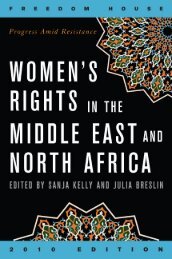Women and Politics in the Third World
Women and Politics in the Third World
Women and Politics in the Third World
You also want an ePaper? Increase the reach of your titles
YUMPU automatically turns print PDFs into web optimized ePapers that Google loves.
ANALYSING WOMEN IN THIRD WORLD POLITICS 9<br />
<strong>and</strong> liberal democratic <strong>the</strong>ory has at its roots <strong>the</strong> separation of <strong>the</strong> public <strong>and</strong> <strong>the</strong><br />
private. Beg<strong>in</strong>n<strong>in</strong>g with Locke, <strong>the</strong> private domestic sphere was seen as ly<strong>in</strong>g<br />
outside of <strong>the</strong> proper realms of <strong>in</strong>vestigation <strong>and</strong> <strong>in</strong>terference by <strong>the</strong> state or<br />
o<strong>the</strong>rs. The public sphere was seen as <strong>the</strong> arena where everyone was <strong>in</strong>corporated<br />
as an <strong>in</strong>dividual citizen <strong>in</strong> <strong>the</strong> political world. Few l<strong>in</strong>ks were made between <strong>the</strong><br />
two spheres <strong>and</strong> <strong>the</strong>oretical attention was focused on <strong>the</strong> public arena, as domestic<br />
life <strong>and</strong> <strong>the</strong> private sphere was assumed to be irrelevant to social <strong>and</strong> political <strong>the</strong>ory.<br />
Of huge significance to <strong>the</strong> study of gender relations were <strong>the</strong> assumptions<br />
underly<strong>in</strong>g this—implicitly <strong>in</strong>dividual citizens active <strong>in</strong> <strong>the</strong> public sphere were<br />
assumed to be male heads of household, <strong>and</strong> women were relegated analytically to<br />
<strong>the</strong> private sphere, subsumed with<strong>in</strong> <strong>the</strong> household headed by <strong>the</strong> <strong>in</strong>dividual male.<br />
This ignores both <strong>the</strong> l<strong>in</strong>ks between <strong>the</strong> two spheres, <strong>and</strong> vary<strong>in</strong>g role played by<br />
<strong>the</strong> state <strong>in</strong> construct<strong>in</strong>g <strong>the</strong> boundary between <strong>the</strong>m. While appear<strong>in</strong>g gender<br />
neutral, ma<strong>in</strong>ta<strong>in</strong><strong>in</strong>g a division between private <strong>and</strong> political life as central to<br />
liberal democracy is ma<strong>in</strong>ta<strong>in</strong><strong>in</strong>g a division between men <strong>and</strong> women, where only<br />
men can be abstract <strong>in</strong>dividuals (Pateman 1983; 1989). The political is <strong>the</strong>refore<br />
def<strong>in</strong>ed as mascul<strong>in</strong>e <strong>in</strong> a very profound sense which makes it hard to <strong>in</strong>corporate<br />
women on <strong>the</strong> same terms as men <strong>and</strong> excludes many of those activities that women<br />
are <strong>in</strong>volved <strong>in</strong> as not political. This is comb<strong>in</strong>ed with an approach which sets up<br />
frameworks <strong>and</strong> <strong>the</strong>ories which, while appear<strong>in</strong>g gender neutral, work to exclude<br />
women. It is not enough <strong>the</strong>n just to get a better underst<strong>and</strong><strong>in</strong>g of <strong>the</strong> role of<br />
women <strong>in</strong> formal politics: a wider analysis, us<strong>in</strong>g broader def<strong>in</strong>itions of <strong>the</strong><br />
political, is needed.<br />
Developments <strong>in</strong> fem<strong>in</strong>ist analyses <strong>in</strong> <strong>the</strong> 1980s have provided new <strong>the</strong>oretical<br />
<strong>in</strong>sights relevant to this endeavour. Before this <strong>the</strong> notion of ‘woman’ as a unitary<br />
<strong>and</strong> a historical category had often been taken for granted. Some fem<strong>in</strong>ists had<br />
treated women as one homogeneous group, mak<strong>in</strong>g <strong>the</strong> assumption that it was both<br />
possible <strong>and</strong> unproblematic to generalise about all women <strong>and</strong> <strong>the</strong>ir <strong>in</strong>terests. This<br />
often meant that <strong>the</strong> experience of white, middle-class <strong>and</strong> Western women was<br />
generalised to black, work<strong>in</strong>g-class <strong>and</strong> <strong>Third</strong> <strong>World</strong> women. As part of a seachange<br />
<strong>in</strong> <strong>the</strong>oretical debates, <strong>the</strong> different ways <strong>in</strong> which <strong>the</strong> category ‘woman’<br />
has been constructed historically have been explored (Riley 1988). The notion of<br />
a ‘women’s <strong>in</strong>terest’ shared by all women regardless of race, class <strong>and</strong> sexuality has<br />
become highly contested.<br />
Three major elements have contributed to <strong>the</strong> breakdown of this k<strong>in</strong>d of<br />
universal <strong>the</strong>oris<strong>in</strong>g (Barrett <strong>and</strong> Phillips 1992). First, black women have provided<br />
a powerful challenge to much of <strong>the</strong> work of white fem<strong>in</strong>ists, argu<strong>in</strong>g that <strong>the</strong>ir<br />
analyses were imbued with racist <strong>and</strong> ethnocentric assumptions, aga<strong>in</strong> generalis<strong>in</strong>g<br />
<strong>the</strong> experience of white fem<strong>in</strong>ists to black women (b hooks 1984; Moraga <strong>and</strong><br />
Anzaldua 1983). Second, <strong>the</strong> re-emergence of <strong>the</strong> ‘equality versus difference’<br />
debate broke down <strong>the</strong> confident dist<strong>in</strong>ctions between sex <strong>and</strong> gender, <strong>and</strong> <strong>in</strong><br />
some quarters sexual difference came to be celebrated ra<strong>the</strong>r than denied (Scott<br />
1988). Debates moved on to ask how to deal with embodiment, argu<strong>in</strong>g that it is<br />
not difference that is <strong>the</strong> problem, but how it is constructed <strong>and</strong> dealt with (Bock




